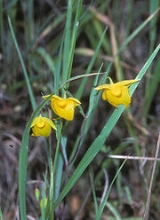
Calochortus amabilis
Encyclopedia
Calochortus amabilis is a species of flowering plant in the lily family
which is known by the common name Diogenes' lantern. It is endemic to northern California
, where it grows in the mountains north of the San Francisco Bay Area
. In oak woodlands common understory plant associates are Calochortus luteus
, Clarkia unguiculata
and Delphinium variegatum
. It is a common member of the scrub and woodland flora there. This is a perennial
herb
producing an upright, somewhat waxy branching stem to heights between 10 and 50 centimeters. The leaf at the base of the stem is flat, waxy, and narrow in shape, reaching up to 50 centimeters long and not withering away at flowering. The inflorescence
bears two or more heavily nodding flowers, each with spreading pointed yellow sepal
s and brown-speckled yellow petal
s. The inside of the petals is waxy and coated in small hairs. The fruit is a winged capsule
up to three centimeters long containing dark brown seeds.
Liliaceae
The Liliaceae, or the lily family, is a family of monocotyledons in the order Liliales. Plants in this family have linear leaves, mostly with parallel veins but with several having net venation , and flower arranged in threes. Several have bulbs, while others have rhizomes...
which is known by the common name Diogenes' lantern. It is endemic to northern California
California
California is a state located on the West Coast of the United States. It is by far the most populous U.S. state, and the third-largest by land area...
, where it grows in the mountains north of the San Francisco Bay Area
San Francisco Bay Area
The San Francisco Bay Area, commonly known as the Bay Area, is a populated region that surrounds the San Francisco and San Pablo estuaries in Northern California. The region encompasses metropolitan areas of San Francisco, Oakland, and San Jose, along with smaller urban and rural areas...
. In oak woodlands common understory plant associates are Calochortus luteus
Calochortus luteus
Calochortus luteus, or Yellow mariposa lily, is a mariposa lily endemic to California.-Description:The primarily a bright deep yellow flower is 3-5cm across and perianth Bulb-shaped, lined red-brown inside, often also with central red-brown blotch and sparse hair inside.-Distribution:This species...
, Clarkia unguiculata
Clarkia unguiculata
Clarkia unguiculata is a species of wildflower known by the common name elegant clarkia. This plant is endemic to California, where it is found in many woodland habitats. Specifically it is common on the forest floor of many oak woodlands, along with typical understory wildflowers that include...
and Delphinium variegatum
Delphinium variegatum
Delphinium variegatum is a species of larkspur known by the common name Royal larkspur. It is endemic to California, where it grows in mountains, valley and coast in woodlands and grasslands...
. It is a common member of the scrub and woodland flora there. This is a perennial
Perennial plant
A perennial plant or simply perennial is a plant that lives for more than two years. The term is often used to differentiate a plant from shorter lived annuals and biennials. The term is sometimes misused by commercial gardeners or horticulturalists to describe only herbaceous perennials...
herb
Herbaceous plant
A herbaceous plant is a plant that has leaves and stems that die down at the end of the growing season to the soil level. They have no persistent woody stem above ground...
producing an upright, somewhat waxy branching stem to heights between 10 and 50 centimeters. The leaf at the base of the stem is flat, waxy, and narrow in shape, reaching up to 50 centimeters long and not withering away at flowering. The inflorescence
Inflorescence
An inflorescence is a group or cluster of flowers arranged on a stem that is composed of a main branch or a complicated arrangement of branches. Strictly, it is the part of the shoot of seed plants where flowers are formed and which is accordingly modified...
bears two or more heavily nodding flowers, each with spreading pointed yellow sepal
Sepal
A sepal is a part of the flower of angiosperms . Collectively the sepals form the calyx, which is the outermost whorl of parts that form a flower. Usually green, sepals have the typical function of protecting the petals when the flower is in bud...
s and brown-speckled yellow petal
Petal
Petals are modified leaves that surround the reproductive parts of flowers. They often are brightly colored or unusually shaped to attract pollinators. Together, all of the petals of a flower are called a corolla. Petals are usually accompanied by another set of special leaves called sepals lying...
s. The inside of the petals is waxy and coated in small hairs. The fruit is a winged capsule
Capsule (fruit)
In botany a capsule is a type of simple, dry fruit produced by many species of flowering plants. A capsule is a structure composed of two or more carpels that in most cases is dehiscent, i.e. at maturity, it splits apart to release the seeds within. A few capsules are indehiscent, for example...
up to three centimeters long containing dark brown seeds.

